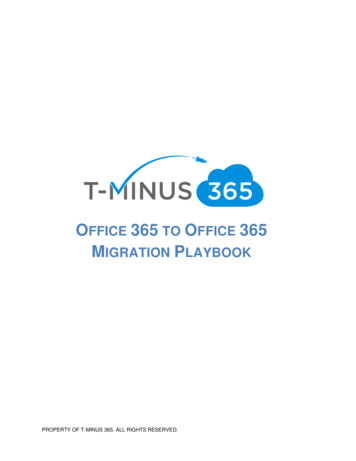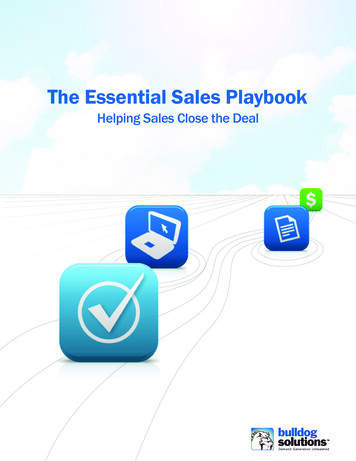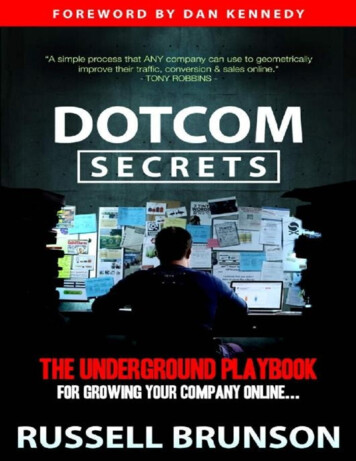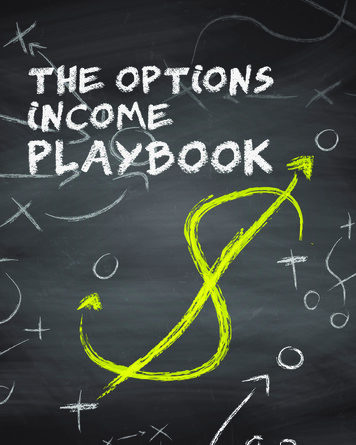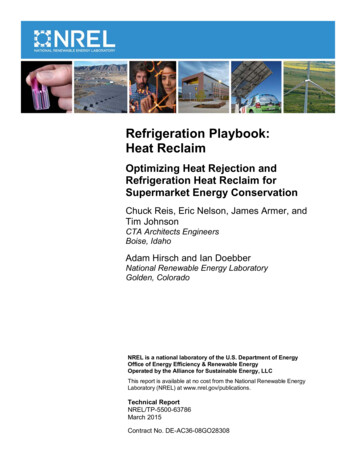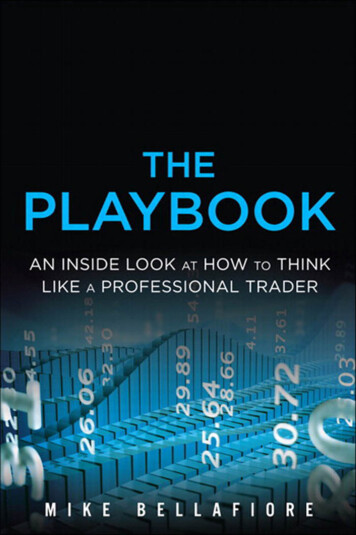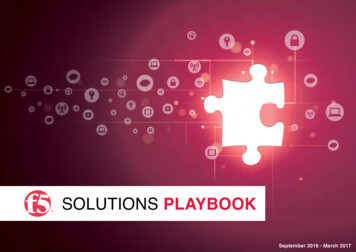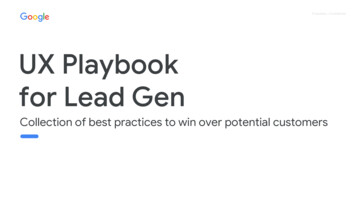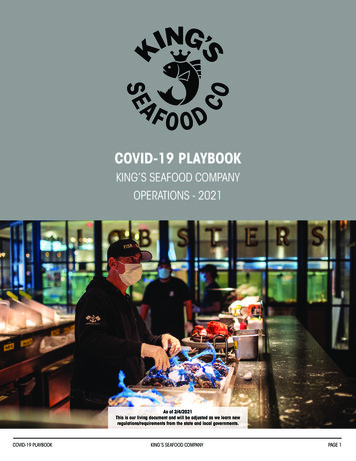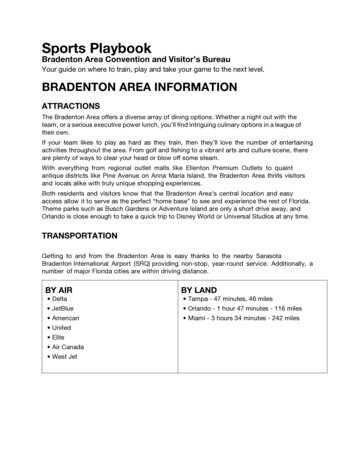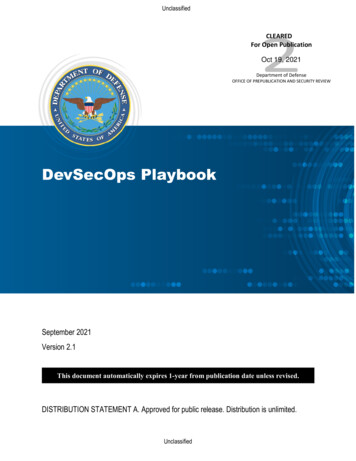
Transcription
UnclassifiedUNCLASSIFIEDCLEAREDFor Open PublicationOct 19, 2021Department of DefenseOFFICE OF PREPUBLICATION AND SECURITY REVIEWDevSecOps PlaybookSeptember 2021Version 2.1This document automatically expires 1-year from publication date unless revised.DISTRIBUTION STATEMENT A. Approved for public release. Distribution is unlimited.UNCLASSIFIEDUnclassified
UNCLASSIFIEDTrademark InformationNames, products, and services referenced within this document may be the trade names,trademarks, or service marks of their respective owners. References to commercial vendors andtheir products or services are provided strictly as a convenience to our readers, and do notconstitute or imply endorsement by the Department of any non-Federal entity, event, product,service, or enterpriseUNCLASSIFIED
UNCLASSIFIEDContentsPlay 1: Adopt a DevSecOps Culture . 4Key Cultural Practices . 4Checklist . 4Play 2: Adopt Infrastructure as Code . 5Key Advantages . 5Checklist . 5Play 3: Adopt Containerized Microservices . 6Key Characteristics of a Containerized Microservice . 6Checklist . 6Play 4: Adopt a Capability Model, not a Maturity Model . 7Checklist . 7Play 5: Drive Continuous Improvement through Key Capabilities . 8Checklist . 8Play 6: Establish a Software Factory . 9Checklist . 9Play 7: Define a Meaningful DevSecOps Pipeline. 10Checklist . 10Play 8: Adapt an Agile Acquisition Policy for Software . 11Checklist . 11Play 9: Tirelessly Pursue Cyber Resilience. 12Checklist . 12Play 10: Shift Test and Evaluation (T&E) Left into the Pipeline . 13Common Testing Categories. 13Checklist . 13Play 11: (Industry) Lean, User-Centered, Agile Practices & Workshops . 14Collection of Lean, User-Centered, Agile Practices and Workshops . 14Popular Topics Related to Modern App Development . 14UNCLASSIFIED3
UNCLASSIFIEDPlay 1: Adopt a DevSecOps CultureDevSecOps is a software engineering culture that guides a team to break down silos and unify softwaredevelopment, deployment, security and operations. Critical to the success of DevSecOps adoption is buy-infrom all stakeholders, including: leadership, acquisition, contracting, middle-management, engineering,security, operations, development, and testing teams. Stakeholders across the organization must change theirway of thinking from “I” to “we”, while breaking team silos, and understanding that the failure to successfullydeliver, maintain, and continuously engineer software and its underlying infrastructure is the failure of the entireorganization, not one specific team or individual.Before beginning a DevSecOps journey, it is imperative to understand that a successful implementation ofDevSecOps cannot be measured by a completely automated pipeline or the interaction between developmentand operations teams alone; all stakeholders in the organization must be committed to changing the way theyview their job responsibilities and, most importantly, interact with each other.Key Cultural Practices Stakeholder transparency and visibility.Complete transparency across team members in real-time.All project resources easily accessible to the entire team; not everyone needs commit privileges.Adopt and embrace ChatOps as the communication backbone for the DevSecOps team.All technical staff should be concerned with, and have a say in, baked-in security.Checklist Learn what is involved in the DevSecOps culture.Embrace automation for anything done repeatedly.Read How to Build a Strong DevSecOps Culture by K. Casey, available online how-build-strong-devsecops-culture-5-tipsRead The Phoenix Project: A Novel about IT, DevOps, and Helping Your Business Win by G. Kim, K.Behr, and G. Spafford, IT Revolution Press, Jan. 10, 2013Fail fast, learn fast, fail small, and do not fail twice for the same reason!UNCLASSIFIED4
UNCLASSIFIEDPlay 2: Adopt Infrastructure as CodeInfrastructure as Code (IaC) is infrastructure definition and configuration that is defined with text files that arechecked-in to a source code repository and kept under configuration management. It includes the managementof networks, storage, virtual machines, load balancers, and even connection topologies. IaC evolved to solve areal-world problem referred to as environment drift in the release pipeline. Succinctly, the developmentenvironment fails to align with the production environment configuration. The goal is to automate allinfrastructure provisioning and configuration in a repeatable, consistent way that also lends itself to peerreviews of the changes prior to any configuration changes actually being made.IaC can take many forms. One is a template for instantiating a cloud service in a secure way. Another isthrough configuration files or scripts. It is important to consider vendor lock-in versus product lock-in whenselecting technology or IaC formats. Blueprints and Cloud Formation only apply to Microsoft Azure andAmazon Web Services (AWS) respectively, creating a degree of vendor lock-in; Cloud-agnostic solutions, suchas those provided by popular tools like Ansible and Terraform, avoid vendor lock-in but create product lock-in.In all cases, the IaC is specified via one or more text files.GitOps is a paradigm where systems are described and observed declaratively, using code to specify thedesired state. The benefits of GitOps build upon IaC, emphasizing the role of git and a git driven workflow. IaCis one of the three core practices of GitOps, along with merge requests and the reliance upon a CI/CD pipeline.Key Advantages IT infrastructure supports and enables change, rather than being an obstacle or a constraint.Mitigates drift between environments by leveraging automation and push-button deployment.Enforces change management through GitOps with multiple approvers, as needed.Environmental changes are routine and fully automated, pivoting staff to focus on other tasks.Quicker recovery from failures, rather than assuming failure can be completely prevented.Empowers a continuous improvement ecosystem rather than “big bang” one and done activities.Checklist Learn how to describe the value proposition of IaC.Understand the benefits of applying GitOps to infrastructure configurations.Understand how IaC tooling selection is a trade-off between vendor lock-in or product lock-in.Explore popular IaC tooling options, including:– Terraform– Ansible– Chef– CSP managed service toolingUNCLASSIFIED5
UNCLASSIFIEDPlay 3: Adopt Containerized MicroservicesA modular open system approach (MOSA) is an acquisition and design strategy consisting of a technicalarchitecture that adopts open standards and supports a modular, loosely coupled and highly cohesive systemstructure. 1 U.S. Code Title 10 Section 2446a, and DoD Instruction 5000.02 require MOSA. A modern softwarearchitecture predicated upon microservices and software containers meet MOSA requirements.A container is a lightweight, standalone, executable package of software that includes everything needed torun a business service except the OS; code, runtime, system tools, system libraries and settings. Containersrun in isolated processes from one another, so several containers can run in the same host OS withoutconflicting with one another. All containers must be Open Container Initiative compliant. 2 The DoD DevSecOpsStrategy requires a CNCF Certified Kubernetes cluster for container orchestration; there over 90 CertifiedKubernetes implementations and counting. 3A microservice architecture is an approach to application development where discrete, modular businessservices are bundled inside of a software container. These business services are then loosely coupled andrapidly composed using lightweight protocols. The primary functional benefit of this approach when executedproperly is that each service can advance independently from the other services. Numerous non-functionalbenefits also exist, including more agility in scaling to demand, multiple upgrade options that don’t impact theuser population, more precise cyber hardening at a per-service level, and inherent support for failure andrecovery.Key Characteristics of a Containerized Microservice Componentization via services.Organized around business capabilities.Product over project.Smart endpoints, dumb pipes.Decentralized governance and data management.Infrastructure automation support via IaC.Design for failure.Evolutionary design support.Checklist Research and understand the benefits of a microservices architecture.Only adopt CNCF Certified Kubernetes to ensure software conformance of required APIs.Leverage Iron Bank for hardened containers and other software artifacts.Always inject the Sidecar Container Security Stack (SCSS) to maximize runtime security.Always adopt a service mesh to further secure east-west network traffic.Defense Acquisition University, “MOSA Defense Acquisition Guidebook, Ch 3-2.4.1.” [Online]. ng.aspx#toc202 The Linux Foundation Projects, “Open Container Initiative,” [Online] Available at: https://opencontainers.org.3 Cloud Native Computing Foundation, “Software Conformance,” [Online] Available ormance/1UNCLASSIFIED6
UNCLASSIFIEDPlay 4: Adopt a Capability Model, not a Maturity ModelGoogle’s DORA research program advocates that rather than use a maturity model, research shows that acapability model is a better way to both encourage and measure performance improvement. 4,5 Multiple studieshave shown that four key metrics support software development and delivery performance. 6 The twocategories are tempo metrics and stability metrics. Under tempo, measure the deployment frequency and thelead time from commit to production deployment. Under stability, measure the mean time to recover fromdowntime or mean time to restore (MTTR) and the change failure rate (or rmersDeployment frequency – How often theorganization deploys code.One demand(multiple deploys perday)Between once perweek and onceper monthBetween once perweek and onceper monthChange lead time – Time it takes to gofrom code commit to code successfullyrunning in production.Less than one hourBetween oneweek and onemonthBetween oneweek and onemonthMean time to recover (MTTR) – Time ittakes to restore service when a serviceincident occurs (e.g., unplanned outage,service impairment).Less than one hourLess than one dayBetween one dayand one weekChange failure rate – Percentage ofchanges that results in either degradedservice or requires remediation (e.g.,leads to service impairment, serviceoutage, requires a hotfix, rollback, patch,etc.)0-15%0-15%31-45%MetricChecklist Become fluent with the four key metrics: deployment frequency, lead time, MTTR, and change failurerate.Evaluate your project and organization on each metric to measure DevSecOps capability progress.Continuously strive to improve each metric through process and automation improvements.Read The DevOps Handbook and learn The Three Ways 7Google Cloud, “Explore DORA’s research program,” [Online]. Available at: https://www.devopsresearch.com/research.html.5 N. Forsgren, J. Humble, G. Kim, and, “Accelerate: The Science of Lean Software and DevOps: Building and ScalingHigh Performing Technology Organizations.” 2018.6 DevOps Research and Assessment (DORA), “Accelerate: State of DevOps 2019.” 2019, [Online]. Available -of-devops-2019.pdf7 G. Kim, J. Humble, P. Debois, and J. Willis, “The DevOps Handbook: How to Create World-Class Agility, Reliability, andSecurity in Technology Organizations.” IT Revolution Press, Oct. 06, 2016.4UNCLASSIFIED7
UNCLASSIFIEDPlay 5: Drive Continuous Improvement through Key CapabilitiesThere are 24 key capabilities that drive improvements across both the DevSecOps team and its organization. 8The capabilities are organized into five broad categories: Continuous Delivery, Architecture, Product andProcess, Lean Management & Monitoring, and Cultural. Cultural change is often the hardest thing toaddress. The 24 key capabilities include:Checklist Read Accelerate: The Science of Lean Software and DevOps: Building and Scaling High PerformingTechnology Organizations.Pay special attention to driving the cultural changes necessary for successful transformation.N. Forsgren, J. Humble, G. Kim, and, “Accelerate: The Science of Lean Software and DevOps: Building and ScalingHigh Performing Technology Organizations.” 2018.8UNCLASSIFIED8
UNCLASSIFIEDPlay 6: Establish a Software FactoryAll custom software development should be driven through the software factory construct using DevSecOps.There are several ways to instantiate a DoD DevSecOps Software Factory / Platform. At this time, the optionwith the least friction is to use the DoD-approved DevSecOps Managed Service Provider (MSP), Platform One.Platform One is operated as an authorized-to-use Platform with integrated continuous authorization to operate(cATO) practices. It leverages several enterprise-class services, including Iron Bank as a recognized DoDhardened artifact repository and Repo One for source code management.Another option is to establish a software factory using a Cloud Service Provider (CSP) with a DoD ATO orProvisional Authorization (PA). Leverage the CSP’s managed services, ideally through IaC practices, toestablish a DevSecOps Software Factory. Figure 1 illustrates the key phases of building a software factory:Figure 1 Software Factory Lifecycle PhasesChecklist Recognize that a software factory must align to the DoD Enterprise DevSecOps Strategy, complywith all required DevSecOps Tools and Activities Guidebook, and clearly identify its interconnectsbetween the various layers, as defined within the DevSecOps Fundamentals document.Software factories are inherently designed to be multi-tenet, and they are expensive to build andoperate; establish clear reasons why a new factory is required over adopting an existing factory.UNCLASSIFIED9
UNCLASSIFIEDPlay 7: Define a Meaningful DevSecOps PipelineEach software factory executes multiple DevSecOps Pipelines, where a pipeline is analogous to amanufacturing assembly line. Each pipeline is dedicated to a specific process uniquely tailored for the artifactbeing produced. There are no one size fits all solutions for cybersecurity testing. Therefore, every DevSecOpspipeline is a collection of process workflows and scripts running on a set of DevSecOps tools operating inunison with their associated software factory. The design of each pipeline must clearly identify the processflows and automation activities across the various DevSecOps stages, depicted below in Figure 2.Figure 2 Unpacked DevSecOps infinity loop showing continuous feedback loopsChecklist Read DoD Enterprise DevSecOps Fundamentals document.Read DevSecOps Tools and Activities Guidebook.Define a software lifecycle within the pipeline that uses management processes that meets the uniqueneeds of the mission environment, system complexity, system architecture, software design choices,risk tolerance level, and system maturity level.Do not try to implement the pipeline using a “big bang” approach – start small, iterate, automaterepetitive processes.Recognize the value of the continuous feedback loops across the software lifecycle phases.Work closely with the AO to understand precisely what each control gate must validate before anartifact can be promoted to the next lifecycle phase.Measure capabilities across each of the lifecycle phases.UNCLASSIFIED10
UNCLASSIFIEDPlay 8: Adapt an Agile Acquisition Policy for SoftwareThe Office of Acquisition Enablers (AE) is a new organization within the Office of the Under Secretary ofDefense for Acquisition & Sustainment (A&S). The office is the lead for enabling innovative acquisitionapproaches that deliver warfighting capability at the speed of relevance. DoD Instruction 5000.02, Operation ofthe Adaptive Acquisition Framework, restructures defense acquisition guidance to improve processeffectiveness and implement the Adaptive Acquisition Framework. 9 As part of this framework, DoD Instruction5000.87, Operation of the Software Acquisition Pathway, became effective October 2, 2020. 10 The 5000.87instruction: Establishes the Software Acquisition Pathway as the preferred path for acquisition and development ofsoftware-intensive systems.Simplifies the acquisition model to enable continuous integration and delivery of software capability ontimelines relevant to the warfighter/end user.Establishes business decision artifacts to manage risk and enable successful software acquisition anddevelopment.Defense Acquisition University (DAU) provides training in the form of an interactive web application thateducates the audience specifically on the Software Acquisition Pathway, where agile software acquisitionprocesses are discussed in the context of acquisition personnel. For more list Review DoDI 8000.87 to understand the formal definition of what constitutes a “software-intensive”system.Review the DIB SWAP study’s key findings. 11Review the acquisition guidance in the TechFAR hub, https://techfarhub.cio.gov/.Recognize that the software can be acquired via DoDI 8000.87, while other program elements can beacquired through different pathways.Leverage Enterprise Level Services as a first choice, if available, before creating unique services.Ensure your acquisition plan recognizes that technology enhancements never end.Do not lock technical requirements into legal contracts; enable new technologies.Office of the Under Secretary of Defense for Acquisition and Sustainment, “DoD Instruction 5000.02, Operation of theAdaptive Acquisition Framework.” Jan. 23, 2020, [Online]. ents/DD/issuances/dodi/500002p.pdf?ver 2020-01-23-144114-093.10 Office of the Under Secretary of Defense for Acquisition and Sustainment, “DoD Instruction 5000.87, Operation of theSoftware Acquisition Pathway.” Oct. 20, 2020, [Online]. ents/DD/issuances/dodi/500087p.PDF?ver virAfQj4v LgN1JxpB dpA%3D%3D.11 Defense Innovation Board (DIB), “Software Acquisition and Practices (SWAP) Study.” May 03, 2019, [Online].Available: IED11
UNCLASSIFIEDPlay 9: Tirelessly Pursue Cyber ResilienceCyber Resilience is “the ability to anticipate, withstand, recover from, and adapt to adverse conditions,stresses, attacks, or compromises on the systems that include cyber resources.” 12 A primary goal ofDevSecOps adoption is to “bake-in” cyber resiliency into applications as part of the software factory’sDevSecOps pipeline process.Cybersecurity touches each of the eight phases of the DevSecOps lifecycle, and the various control gatesserve as Go/No-Go decision points. As discussed in Play 7: Define a Meaningful DevSecOps Pipeline, theprecise set of testing and processes will vary from pipeline to pipeline. However, all pipelines must use thesecontrol gates to ensure that cybersecurity is both “baked in” and transparently identified. Culturally, the AO andtheir staff must pivot from relying on post-process paperwork evaluations to near real-time continuousmonitoring of both the software factory’s pipelines and the production environment performance metrics.Moving to DevSecOps includes moving towards a Continuous Authorization to Operate (cATO) for anapplication developed using DevSecOps processes, including a software factory with a CI/CD pipeline. cATOis equivalent to an ongoing authorization as defined in NIST 800-137, and it is fundamentally related to theongoing understanding and acceptance of security and privacy risk. 13 Every cATO is centered around atransparently defined and well-understood continuous monitoring program.A separate guidebook on cATO is forthcoming; it centers around assessment and authorization of the platform,assessment and authorization of the process (including continuous monitoring), and finally, assessment andauthorization of the team.Checklist Do not use Fast Track Authority to Operate for software produced by a DevSecOps software factoryCI/CD pipeline.Pursue cyber resilience at each phase of the DevSecOps lifecycle.Understand Recommendation B6, “Shift from certification of executables for low- and medium-riskdeployments to certification of code/architectures and certification of the development, integration, anddeployment toolchain.”11Establish a continuous monitoring program.Partner with your AO and help them move to near real-time metrics dashboard.12 R. Ross, V. Pillitteri, R. Graubart, D. Bodeau, and R. McQuiad, “NIST Special Publication 800-160 Volume 2,Developing Cyber Resilient Systems: A Systems Security Engineering Approach.” 2019–Nov., [Online]. 2.13 National Institute of Standards and Technology, “Risk Management Framework for Information Systems andOrganizations: A System Life Cycle Approach for Security and Privacy (SP 800-37 Rev. 2).” Dec. 2018, [Online].Available: 7/rev-2/final.UNCLASSIFIED12
UNCLASSIFIEDPlay 10: Shift Test and Evaluation (T&E) Left into the PipelineThe Defense Innovation Board succinctly summed the goal of this play like this: “Speed and cycle time are themost important metrics for managing software. DoD must be able to deploy software faster without sacrificingits abilities to test and validate software.”11Developmental Test and Evaluation (DT&E) and Operational Test and Evaluation (OT&E) activities areintended to gather data that helps leadership make informed decisions. The value of shifting test andevaluation activities into the software factory’s pipeline is that risk is reduced by finding problems early andfixing them fast while the change that created the problem is still in the forefront of the developer’s mind.Integration continues to be difficult to achieve between disparate systems, and the push for access to raw datato feed AI/ML algorithms is increasing, not decreasing. The ability to ensure these integrations work earlier inthe process, not as a bolt-on after-the-fact integration, drives the delivery of relevant software at the speed ofoperations.Tests must be planned, and the need for testing activities is formally identified within the DoDI 5000.87 andDoDI 5000.89.10 Testers should receive formal training in both Agile and DevSecOps to ensure they are fullyintegrated team members. Further, the DevSecOps culture emphasizes that everyone is responsible for testingand quality regardless of team position or job title. The test plan must plan and identify the metrics that bestreflect functional and non-functional requirements and how the metrics will be collected in an automatedfashion, respectively. Lastly, and most importantly, the end user or their representative must be closelyinvolved in all aspects of testing and acceptance of an artifact as it transitions through the CI/CD pipeline.Common Testing Categories Unit and Functional Testing.Integration Testing.Performance Testing.Interoperability Testing.Deployment Testing (normally conducted in a dev, test, or integration environment).Operational Testing (normally conducted in a pre-production or production environment).Static Application Security Testing (SAST).Dynamic Application Security Testing (DAST).Interactive Application Security testing (IAST).Runtime Application Self-Protection (RASP).Cybersecurity Test and Evaluation (see DoD Cybersecurity Test and Evaluation Guidebook)Checklist Start all T&E planning at the inception of the program to influence strategy, requirements, RFPs, etc.Establish the plan to automate the collection of test data metrics in the first sprint.Incessantly work to compress test reporting timelines as much as possible to speed corrections.Include operational users in both Developmental and Operational Testing.Incorporate all forms of Application Security Testing in the pipeline to ensure cyber resilience.Consider functional, non-functional, and cyber testing at each of the eight phases of the DevSecOpslifecycle.UNCLASSIFIED13
UNCLASSIFIEDPlay 11: (Industry) Lean, User-Centered, Agile Practices & WorkshopsTanzu Labs has assembled a collection of guides and playbooks for topics like Spring, Kubernetes,Containers, Microservices, Python, CI/CD, etc. They have also developed a collection of lean, user-centered,agile practices and workshops for modern software application development. This material is used to buildTanzu software as well as teach other software developers how to build their own modern softwareapplications.These guides and playbooks are open source and available at the Tanzu Developer Center at the URLsindicated below.Collection of Lean, User-Centered, Agile Practices and Workshops ar Topics Related to Modern App Development FIED14
Oct 19, 2021 · The Phoenix Project: A Novel about IT, DevOps, and Helping Your Business Winby G. Kim, K. Behr, and G. Spafford, IT Revolution Press, Jan. 10, 2013 Fail fast, learn fas
